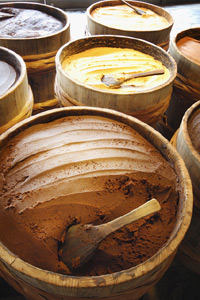 Japanese Fermented FoodsFermented foods are made by taking advantage of the workings of microorganisms and enzymes in food ingredients. The Japanese have a long history of making fermented foods a close part of everyday life. In fact, these foods are an essential part of the daily diet in Japan. Two essential condiments, for example, are miso (fermented soybean paste) and soy sauce, both of which are made from soybeans. Similarly, natto is made of fermented soybeans and eaten with warm rice as a standard breakfast food. As a side dish, tsukemono (Japanese pickles) is made by fermenting vegetables in nuka, or rice bran, and as a snack to go with alcohol, shiokara is a delicacy of fermented seafood with fish entrails.
Japanese Fermented FoodsFermented foods are made by taking advantage of the workings of microorganisms and enzymes in food ingredients. The Japanese have a long history of making fermented foods a close part of everyday life. In fact, these foods are an essential part of the daily diet in Japan. Two essential condiments, for example, are miso (fermented soybean paste) and soy sauce, both of which are made from soybeans. Similarly, natto is made of fermented soybeans and eaten with warm rice as a standard breakfast food. As a side dish, tsukemono (Japanese pickles) is made by fermenting vegetables in nuka, or rice bran, and as a snack to go with alcohol, shiokara is a delicacy of fermented seafood with fish entrails.
One of the reasons why Japan has so many fermented foods is that the country’s temperature and humidity levels are conducive to the reproduction of bacteria and other microorganisms that stimulate fermentation. Mold such as aspergillus is used for fermentation, as is yeast fungus, lactic acid bacteria, natto bacillus and other fungi. Through the workings of these kinds of fermentation bacteria, a savory taste is produced and extracted, making it possible to produce healthy, nutrient-rich food that can be preserved for long periods. Japanese people have long been aware of this fact through experience.
Read more from here.>>Trends in Japan
http://web-japan.org/trends/11_lifestyle/lif120223.html
Read the original article at
http://shine.yahoo.com/healthy-living/7-foods-burn-fat-214600519.html
